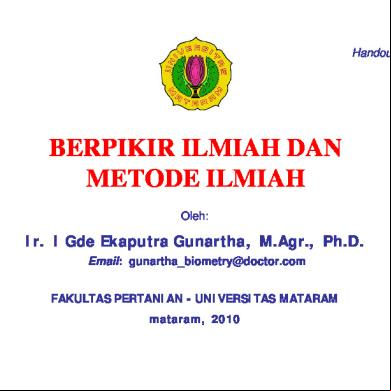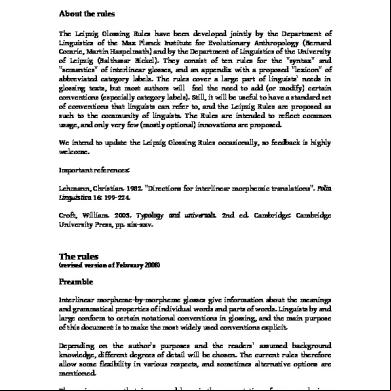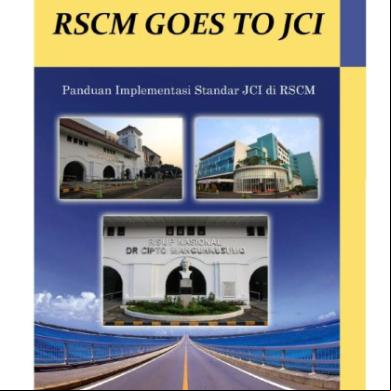Phonol 2 Handout 3r53h
This document was ed by and they confirmed that they have the permission to share it. If you are author or own the copyright of this book, please report to us by using this report form. Report 3b7i
Overview 3e4r5l
& View Phonol 2 Handout as PDF for free.
More details w3441
- Words: 742
- Pages: 4
ENGL 4/540
Nov 8, 2011 Phonology Pt. 2
Outline • Phonemes, allophones (complementary distribution), phonology problems [LAST WEEK’S HANDOUT] • Phonological rules (underlying forms, formalization), examples • Rule ordering • Allomorphy (English plural, English past tense: study on own): Finegan: 123-125 • Syllable structure: nucleus, onset, rhyme, phonotactic constraints ===================================== 1.
Process of phonological analysis 1. Look for minimal pairs (or near minimal pairs). •
near minimal pairs: only sounds surrounding the sounds in questions are identical, not the entire words, e.g. mission [mɪʃəәn] ~ vision [vɪʒəәn]
2. List environments of allophones. 3. Generalize the environments to for any natural class of sounds. 4. Determine the underlying form. 5. Formalize statement of complementary distribution using a phonological rule. 2.
underlying forms of a morpheme or word are composed of only phonemes (distinctive sounds, sounds that are not predictable). these are the items assumed to be stored in the lexicon. (Finegan: 116) •
surface form: a word’s actual pronunciation after phonological rules apply.
•
see Finegan Table 4-5, p. 116
3.
How to select an underlying form: The underlying form should be the variant that occurs in the largest numbers of environments (basic or elsewhere variant). It should be the most difficult to derive by rule.
4.
Phonological rules (descriptive rules of phonological patterns) Formal statements of complementary distribution: A B /X____Y “A becomes B in the environment following X and preceding Y” A=UR (underlying form; it’s a phoneme so appears in / / notation); theoretically what’s stored in the lexicon) B=change UR undergoes (if B is a sound, it should be in [ ] notation.) /=in the environment of X & Y=phonetic environment in which change occurs
5.
Examples of rules a.
English vowel lengthening (before voiced consonants) English vowels lengthened before voiced Cs (predictable process; short and long vowels in complementary distribution in English), e.g. vowel lengthening rule applies to the underlying form slide /slajd/ to produce [slajːd] V → Vː / __ C [+ voice] UR
b.
PHONETIC ENVIRONMENT
Korean [r] and [l] (11. on last week’s handout) /l/ → [r] / _ V
c.
English V nasalization: /bæŋ/ [bæ̃ŋ] V[+nasal]/____C [+nasal]
d.
English: aspiration of voiceless stops C [+stop, -voice] aspirated/ #___ C [+stop, -voice] aspirated/$___ V [+stress]
e.
German final (obstruent) devoicing: e.g. German: Zug 'train', pronounced [ʦuːk] C→ [-voice]/___#
f.
English flapping, e.g. water, phonetics, rider alveolar stop→flap/V___V [-stress]
g.
assimilation: a phonological process whereby a sound becomes phonetically similar to a neighboring sound. e.g. English V nasalization, English flapping, German final devoicing (in a sense)
2
6.
7.
Problem sets a.
Zinacantex Tzotzil (Mayan): [p] and [p’] (apostrophe indicates a glottalized sound)
1. 2. 3. 4. 5. 6.
pim nopol p’us p’in p’ol pus
b.
Oneida (Iroquoian): [s] and [z]
1. 2. 3. 4. 5. 6. 7.
lashet laʔsluni lazel tahazehteʔ loteswatu skahnehtat thiskate
‘thick’ ‘nearby’ ‘hunchback’ ‘pot’ ‘to multiply’ ‘jail’
‘let him count’ ‘white men’ ‘let him drag it’ ‘he dropped it’ ‘he’s been playing’ ‘one pine tree’ ‘a different one’
8. 9. 10. 11. 12. 13.
kawenezuzeʔ khaiize sninuhe tuzahatiteni wahsnestakeʔ wezake
‘long words’ ‘I’m taking it along’ ‘you buy’ ‘they changed it’ ‘you ate corn’ ‘she saw you’
Rule ordering (Finegan Table 4-6 and 4-7, p. 118) Vowel lengthening rule: VV:/__C [+voice] Flapping rule:
8.
9.
alveolar stop→flap/V___V [-stress]
Regular allomorphy in the English plural, possessive, 3s morphemes •
allomorphs of the regular English plural: Finegan: 123
•
learn past tense allomorphy on your own
syllable is a phonological unit consisting of one or more phonemes. Preferred syllable crosslinguistically is CV. •
Finegan: 119
•
structure of syllable: (a) RHYME consists of: (i) NUCLEUS (usually vowel but may be syllabic C) and (ii) CODA (consonants following nucleus) and (b) ONSET (consonants preceding rhyme).
•
Examples: through [θru], computer [kəәm-phju-ɾəәr]; also Finegan: 120
3
10.
PHONOTACTIC or SEQUENCE CONSTRAINTS:
the set of constraints on how sequences of
sounds pattern in a language. 11.
12.
13.
Possible and impossible words in English /blit/ /dʒaŋk/
/pnor/ /dʒank/
/grɪfəl/
/dʒloh/
English has a wide range of syllable types with respect to consonant clusters: [wɚldz]
CVCCC
[strɛŋkθ]
CCCVCCC
[twelfθs]
CCVCCCC
Three consonant onsets in English j w r l sp spew spring split st (stupid) strip sk skewer squeak scrap sclerosis
14.
Obstruent-approximant clusters •
many languages have this pattern, though the inventory varies greatly.
•
approximant serves as transition between more closed obstruents at edges of syllable to more open vowels at the center.
4
Nov 8, 2011 Phonology Pt. 2
Outline • Phonemes, allophones (complementary distribution), phonology problems [LAST WEEK’S HANDOUT] • Phonological rules (underlying forms, formalization), examples • Rule ordering • Allomorphy (English plural, English past tense: study on own): Finegan: 123-125 • Syllable structure: nucleus, onset, rhyme, phonotactic constraints ===================================== 1.
Process of phonological analysis 1. Look for minimal pairs (or near minimal pairs). •
near minimal pairs: only sounds surrounding the sounds in questions are identical, not the entire words, e.g. mission [mɪʃəәn] ~ vision [vɪʒəәn]
2. List environments of allophones. 3. Generalize the environments to for any natural class of sounds. 4. Determine the underlying form. 5. Formalize statement of complementary distribution using a phonological rule. 2.
underlying forms of a morpheme or word are composed of only phonemes (distinctive sounds, sounds that are not predictable). these are the items assumed to be stored in the lexicon. (Finegan: 116) •
surface form: a word’s actual pronunciation after phonological rules apply.
•
see Finegan Table 4-5, p. 116
3.
How to select an underlying form: The underlying form should be the variant that occurs in the largest numbers of environments (basic or elsewhere variant). It should be the most difficult to derive by rule.
4.
Phonological rules (descriptive rules of phonological patterns) Formal statements of complementary distribution: A B /X____Y “A becomes B in the environment following X and preceding Y” A=UR (underlying form; it’s a phoneme so appears in / / notation); theoretically what’s stored in the lexicon) B=change UR undergoes (if B is a sound, it should be in [ ] notation.) /=in the environment of X & Y=phonetic environment in which change occurs
5.
Examples of rules a.
English vowel lengthening (before voiced consonants) English vowels lengthened before voiced Cs (predictable process; short and long vowels in complementary distribution in English), e.g. vowel lengthening rule applies to the underlying form slide /slajd/ to produce [slajːd] V → Vː / __ C [+ voice] UR
b.
PHONETIC ENVIRONMENT
Korean [r] and [l] (11. on last week’s handout) /l/ → [r] / _ V
c.
English V nasalization: /bæŋ/ [bæ̃ŋ] V[+nasal]/____C [+nasal]
d.
English: aspiration of voiceless stops C [+stop, -voice] aspirated/ #___ C [+stop, -voice] aspirated/$___ V [+stress]
e.
German final (obstruent) devoicing: e.g. German: Zug 'train', pronounced [ʦuːk] C→ [-voice]/___#
f.
English flapping, e.g. water, phonetics, rider alveolar stop→flap/V___V [-stress]
g.
assimilation: a phonological process whereby a sound becomes phonetically similar to a neighboring sound. e.g. English V nasalization, English flapping, German final devoicing (in a sense)
2
6.
7.
Problem sets a.
Zinacantex Tzotzil (Mayan): [p] and [p’] (apostrophe indicates a glottalized sound)
1. 2. 3. 4. 5. 6.
pim nopol p’us p’in p’ol pus
b.
Oneida (Iroquoian): [s] and [z]
1. 2. 3. 4. 5. 6. 7.
lashet laʔsluni lazel tahazehteʔ loteswatu skahnehtat thiskate
‘thick’ ‘nearby’ ‘hunchback’ ‘pot’ ‘to multiply’ ‘jail’
‘let him count’ ‘white men’ ‘let him drag it’ ‘he dropped it’ ‘he’s been playing’ ‘one pine tree’ ‘a different one’
8. 9. 10. 11. 12. 13.
kawenezuzeʔ khaiize sninuhe tuzahatiteni wahsnestakeʔ wezake
‘long words’ ‘I’m taking it along’ ‘you buy’ ‘they changed it’ ‘you ate corn’ ‘she saw you’
Rule ordering (Finegan Table 4-6 and 4-7, p. 118) Vowel lengthening rule: VV:/__C [+voice] Flapping rule:
8.
9.
alveolar stop→flap/V___V [-stress]
Regular allomorphy in the English plural, possessive, 3s morphemes •
allomorphs of the regular English plural: Finegan: 123
•
learn past tense allomorphy on your own
syllable is a phonological unit consisting of one or more phonemes. Preferred syllable crosslinguistically is CV. •
Finegan: 119
•
structure of syllable: (a) RHYME consists of: (i) NUCLEUS (usually vowel but may be syllabic C) and (ii) CODA (consonants following nucleus) and (b) ONSET (consonants preceding rhyme).
•
Examples: through [θru], computer [kəәm-phju-ɾəәr]; also Finegan: 120
3
10.
PHONOTACTIC or SEQUENCE CONSTRAINTS:
the set of constraints on how sequences of
sounds pattern in a language. 11.
12.
13.
Possible and impossible words in English /blit/ /dʒaŋk/
/pnor/ /dʒank/
/grɪfəl/
/dʒloh/
English has a wide range of syllable types with respect to consonant clusters: [wɚldz]
CVCCC
[strɛŋkθ]
CCCVCCC
[twelfθs]
CCVCCCC
Three consonant onsets in English j w r l sp spew spring split st (stupid) strip sk skewer squeak scrap sclerosis
14.
Obstruent-approximant clusters •
many languages have this pattern, though the inventory varies greatly.
•
approximant serves as transition between more closed obstruents at edges of syllable to more open vowels at the center.
4










